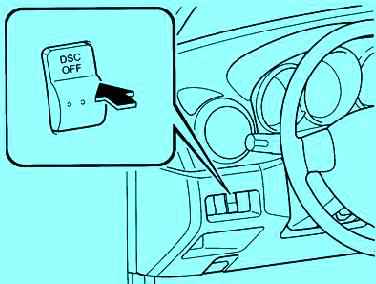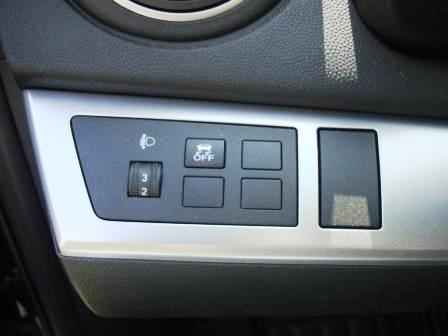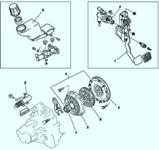Mazda 3 motion stabilization systems
Traction control system (TCS)
The traction control system (PBS) improves the traction properties of the car and traffic safety by regulating the torque developed by the engine and braking the slipping wheel
If the PBS system detects the slip of the drive wheel, it will command to reduce the engine torque and apply the appropriate wheel brake.
This prevents the wheel from slipping and reducing traction.
Thus, on a slippery surface, the fuel supply to the engine is automatically regulated, and the optimal torque is supplied to the wheels, which eliminates intensive wheel slip and a decrease in the adhesion force of the wheels to the ground.
To turn off the DSC system, press the "DSC OFF" switch.
Activation indicator/fault indicator for traction control and anti-skid systems.
The indicator lights up for a few seconds when the ignition switch is turned to the "ON" (ignition on) position.
The indicator flashes when the traction control system (SBS) or anti-skid system (CCD) is activated.
If the indicator continues to light, the normal functioning of the PBS and CCD systems may be impaired.
The flashing of the signaling device may be accompanied by a low characteristic noise coming from the engine compartment. This indicates the normal operation of the traction control system.
When driving on slippery road surfaces, such as fresh snow, the engine will not be able to develop high speeds if the PBS system is enabled.
Anti-skid system (DSC)
The Anti-Skid System (ACS) automatically controls wheel braking and regulates the torque developed by the engine, in conjunction with the anti-lock and traction control systems, which eliminates side slip and skidding of the car when driving on slippery road surfaces or during sharp and vigorous maneuvering.
Anti-skid system improves vehicle safety.
Anti-skid system operates at vehicle speeds above 20 km/h.
The anti-skid system may not function properly if the following conditions are not met.
The same tires of the recommended size must be installed on all wheels of the car.
All wheels must be fitted with tires of the same make, model, size and tread pattern, manufactured in the same factory.
It is forbidden to install tires with varying degrees of tread wear on a car.
The anti-skid system may not work properly if snow chains are installed on the wheels or one of the wheels is replaced with a small spare tire.
The reason for the violation of the normal functioning of the anti-skid system is the difference in the rolling radii of the wheels.
After turning the ignition switch to the "ON" (ignition on) position, a clicking sound may be heard from the instrument panel.
It accompanies the self-diagnosis of the anti-skid system and does not indicate any malfunction.
Activation indicator/fault indicator for traction control and anti-skid systems.
The indicator lights up for a few seconds when the ignition switch is turned to the "ON" (ignition on) position.
The indicator flashes when the traction control or anti-skid system is activated.
If the indicator continues to burn, this may indicate a malfunction of the PBS and CCD systems.
Contact your authorized Mazda dealer to have your vehicle checked.
An indicator that the anti-skid system is disabled.
The indicator lights up for a few seconds when the ignition switch is turned to the "ON" (ignition on) position.
The indicator also comes on when the "DSC OFF" switch is pressed and warns the driver that the traction control and anti-skid systems are disabled.
DSC OFF switch.

To disable the traction control and anti-skid systems, press and hold the DSC OFF switch until the DSC OFF indicator lights up.

Press the switch again to turn the PBS/CCD systems back on. The DSC OFF indicator will turn off.
If the CCD system is not disabled, then when trying to if the car is stuck, the traction control system will work.
When you press the accelerator pedal, the engine torque will not increase.
In such cases, turn off the PBS/CCD systems.
Disabled when the engine is off, the PBS / PZS system turns on automatically when the ignition is turned on.
For the stability of the car, the traction control and anti-skid systems must be turned on.
Rear suspension stabilization
When the load on the rear wheels increases, the deformation of the rear suspension springs is deformed, the rear part of the body drops and the ground clearance decreases.
The stabilization device automatically maintains the ground clearance at a given level.
The rear suspension stabilizes as the vehicle moves. Stable ground clearance improves driving stability and ride comfort.
The ground clearance stabilizes when the load on the rear wheels is increased by about 140-300 kg.
Ride height stabilization in the rear suspension area is not possible if the load weight is too low or exceeds 300 kg
In order for the ground clearance to return to the set level, it is necessary to drive a distance of 4-5 km in urban conditions or 8-10 km on the highway.
However, the indicated distances may vary depending on the load and its location.
The ground clearance will increase after the vehicle is unloaded. After the car has traveled a distance of 0.4-0.5 km, the ground clearance will return to the set level.











